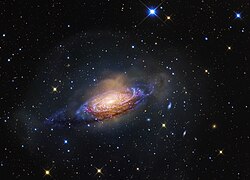| NGC 3521 | |
|---|---|
 NGC 3521 imaged by the Hubble Space Telescope | |
| Observation data (J2000 epoch) | |
| Constellation | Leo |
| Right ascension | 11h 05m 48.581s [1] |
| Declination | –00° 02′ 09.11″ [1] |
| Redshift | 0.002672 [1] |
| Heliocentric radial velocity | 801 [2] km/s |
| Distance | 37.17 ± 1.83 Mly (11.395 ± 0.56 Mpc) [1] |
| Apparent magnitude (V) | 11.0 [1] |
| Characteristics | |
| Type | SAB(rs)bc [2] |
| Size | ~146,000 ly (44.75 kpc) (estimated) [1] |
| Apparent size (V) | 11′.0 × 5′.1 [1] |
| Notable features | HII LINER |
| Other designations | |
| Bubble Galaxy [3] , IRAS 11032+0014, UGC 6150, MCG +00-28-030, PGC 33550, CGCG 010-074 [1] | |
NGC 3521 is a flocculent [4] intermediate spiral galaxy located in the constellation Leo. Its velocity with respect to the cosmic microwave background is 1167 ± 26 km/s, which corresponds to a Hubble distance of 56.1 ± 4.1 Mly (17.21 ± 1.26 Mpc ). [1] However, 26 non-redshift measurements give a much closer distance of 37.17 ± 1.83 Mly (11.395 ± 0.56 Mpc). [5] It was discovered by German-British astronomer William Herschel on 22 February 1784. [6]
Contents

NGC 3521 has a morphological classification of SAB(rs)bc, [2] which indicates that it is a spiral galaxy with a trace of a bar structure (SAB), a weak inner ring (rs), and moderate to loosely wound arm structure (bc). [7] The bar structure is difficult to discern, both because it has a low ellipticity and the galaxy is at a high inclination [2] of 72.7° to the line of sight. [4] The relatively bright bulge is nearly 3/4 the size of the bar, which may indicate the former is quite massive. [2] The nucleus of this galaxy is classified as an HII LINER, [8] as there is an H II region at the core and the nucleus forms a low-ionization nuclear emission-line region.
NGC 3521 is structurally similar to the Milky Way; additionally, its supermassive black hole has a similar mass to that of the Milky Way, at about 7 million solar masses. [9]